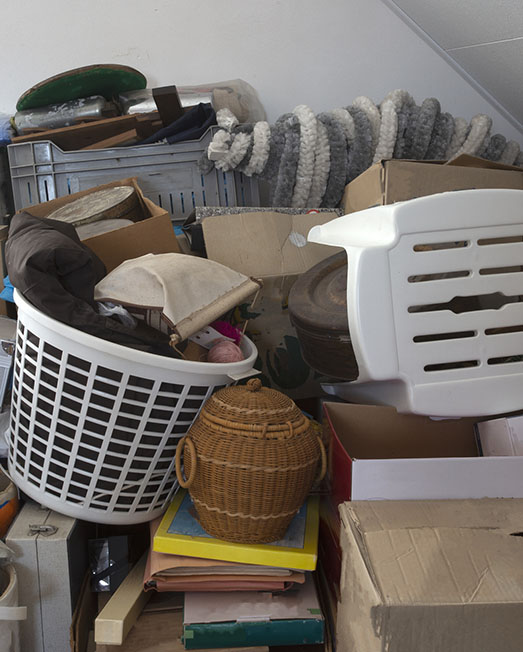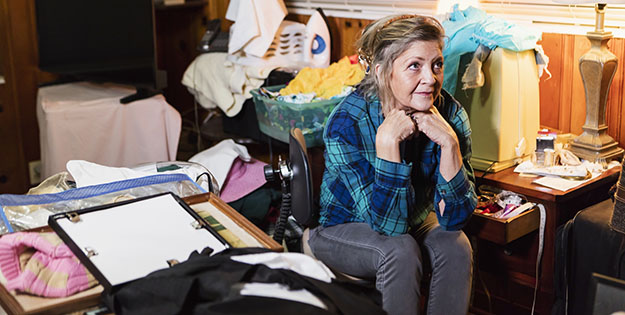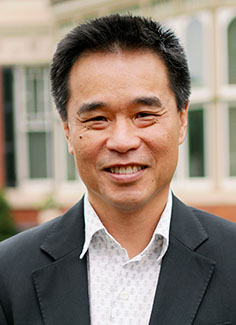Lifestyle
Copyright@ Australian Catholic University 1998-2025 | ABN 15 050 192 660 CRICOS registered provider: 00004G | PRV12008
Copyright@ Australian Catholic University 1998-2025 | ABN 15 050 192 660 CRICOS registered provider: 00004G | PRV12008

On the reality TV show Hoarders, the camera frequently brings its focus on things that most people would find repulsive: mouldy walls, piles of debris, fridges filled with rotten food. “People throw away a lot of things,” says Gerri, a woman whose house is so crammed with stuff that the city council declares it unhabitable. “I don’t. I’ve got everything in there.”
Hoarding disorder – a persistent difficulty in discarding possessions regardless of their actual value, resulting in the chaotic cluttering of living areas – is a mental illness that affects an estimated 1.2 million Australians. And yet, it is widely misunderstood.
While experts concede that the aforementioned TV show has put the disorder on the public radar in an unparalleled way, many also believe that its sensationalised portrayal of hoarding is problematic.
“People with hoarding disorder live with a level of shame, and I think that’s partly due to programs like Hoarders,” says ACU’s Associate Professor Keong Yap, a clinical psychologist whose research has focused on hoarding disorder and other compulsive behaviours.
“It has the effect of ‘othering’ people with hoarding disorder, and if we mock and shame people who have hoarding tendencies, that often prevents them from asking for help and seeking treatment. It reduces their social contact, isolating them even further, and that can really intensify the problem.”
Dr Keong Yap’s interest in hoarding stems from his time as a clinician in Melbourne, where he worked closely with patients suffering from obsessive compulsive disorder (OCD).
At the time, hoarding was still believed to be a symptom or subtype of OCD; it wasn’t officially recognised as a distinct disorder until 2013, almost two decades after psychologists Randy Frost and Tamara Hartl published the first-ever theoretical model of hoarding.
Through their research, Frost and Hartl were starting to see symptoms of hoarding that were not related to OCD at all.
“So they started to query, is this a separate disorder?” says Dr Yap, whose early research was also focused on OCD. “They realised that the three major dimensions of hoarding – excessive collecting, difficulty in discarding, and the creation of clutter – these behaviours could sometimes be symptoms of OCD and other psychological conditions, but in many cases, hoarding stood apart from obsessive compulsive subtypes.”
One of the main clinical benefits of classifying hoarding as a distinct disorder was that treatment could be better tailored for those diagnosed with the condition. Rather than prescribing treatments designed for OCD patients, psychologists began recommending a form of Cognitive Behavioural Therapy (CBT) designed specifically to treat hoarding disorder.
It remains the only evidence-based treatment for the condition; however, it is far from perfect, with recent reviews showing that only a third of patients experience significant improvements.
“All clinicians and researchers in this area recognise that we need to do better with our treatment for hoarding disorder,” says Dr Yap, who has conducted various studies on the effectiveness of CBT in treating the condition.
“It’s such a complex problem, and right now, while CBT works for some, it’s not like everyone who goes through the treatment suddenly finds that their house is cleared of clutter and the problem has gone away. The search is on, and there are a lot of researchers currently trying to modify treatments, to add in components and see if we can improve outcomes and improve lives.”
The major elements of CBT include challenging dysfunctional beliefs around hoarding and possessions, gradual exposure to discarding things and resisting acquiring new ones, and dealing with informational processing problems. In Australia, Catholic Healthcare runs the CBT-related Buried in Treasures, based on a program pioneered by Randy Frost and other psychologists, and Lifeline runs Harbour to Hawkesbury, which focuses on common hoarding problems and improving social connections.
Meanwhile, Dr Yap’s research is aimed at addressing the problems that people with hoarding disorder have with loneliness, interpersonal difficulties, and relationship insecurity.
“The theory is that if people are less lonely, it will reduce their attachment to objects,” he says, “and if they’re clinging less tightly to the possessions they’ve hoarded, discarding them might become a lot easier.”
So, why do people with hoarding disorder cling to the stuff they’ve accumulated?
Most people have cherished possessions to which we are emotionally attached: a souvenir from an overseas trip, a family heirloom, a book signed by a favourite author. This is what psychologists describe as a secure object attachment.
“When we look at an item and we cherish that item, it’s like a trinket and it brings about really fond memories that give us pleasure,” says Dr Yap, whose research has explored the role of object attachment in hoarding disorder.
“Those items are held with an attachment that is secure: you like these possessions, you hold onto them, sometimes you think about them, but you do not cling to them. You can let them go, and even if they’re lost, it won’t cause you an overwhelming amount of anxiety.”

Conversely, people with hoarding disorder have insecure object attachments. They tend to become attached to a large number of items, including objects that most people would eagerly discard, and have an intense fear of losing these possessions.
In his study, Dr Yap and his colleague Professor Jessica Grisham contend that a person engaging in compulsive hoarding has “a need to be close to possessions, and feelings of vulnerability when separated from belongings”.
This behaviour, they add, is “underpinned by the tendency to imbue objects with human-like qualities and to use objects as extensions of their identity”.
Known to behavioural scientists as anthropomorphism, this process involves the attribution of human characteristics or behaviour to inanimate objects; just like Wilson, the volleyball that served as a companion to a plane crash survivor in the film, Cast Away.
“Some people, we might see an object like a teacup, and we look at it closely and say, ‘Oh, look! I can see a smiley face,’ so we imbue human qualities to it,” Dr Yap says. “It’s a natural human tendency, but some people are more prone to it than others, and what we’re seeing is that people who are more likely to anthropomorphise also seem to be predisposed to hoarding problems.”
In childhood, many of us anthropomorphise when we use teddy bears or comforters to compensate for the absence of a parent. By the time we’ve reached adolescence, we generally discard these items – and yet, we retain a basic need for social connection and relatedness.
“When people who don’t have hoarding disorder are lonely, when they have unmet relatedness needs, they can turn to objects and they do fulfill that sense of loneliness, that sense of emptiness – it actually works,” Dr Yap says. “So I might feel a bit lonely and take out my photo album, I look at my family in Singapore, I scroll through these pictures and I feel less lonely. I use the object to feel connected.”
The difference with people who compulsively hoard is that objects fail to compensate for their unmet relatedness needs.
“They hoard things to compensate for their loneliness, to soothe themselves and find comfort and safety, but because their attachment to the object is insecure, it causes them anxiety and fails to meet that need,” says Dr Yap, whose recent study showed high levels of loneliness in people with hoarding disorder.
“In fact, it pushes other people away and they feel even more lonely, because all that clutter results in their loved ones being angry with them, and they have arguments and there’s a lot of hostility in their interpersonal relationships, so they feel even more lonely and it just becomes a vicious cycle.”
As Betty, a woman who has featured on the TV show Hoarders says of her stuff: “It’s always there, and my family isn’t.”
Perhaps if we can help people with hoarding disorder feel loved and valued, rather than lonely and ashamed, they may benefit more from treatment and recover from their illness.
Dr Keong Yap is a clinical psychologist and Associate Professor at ACU’s School of Behavioural and Health Sciences. His research focusses on hoarding disorder, OCD, and compulsive buying. He is also interested in examining mindfulness and acceptance-based therapies for these conditions.

Interested in psychology? Explore our courses.
Copyright@ Australian Catholic University 1998-2025 | ABN 15 050 192 660 CRICOS registered provider: 00004G | PRV12008